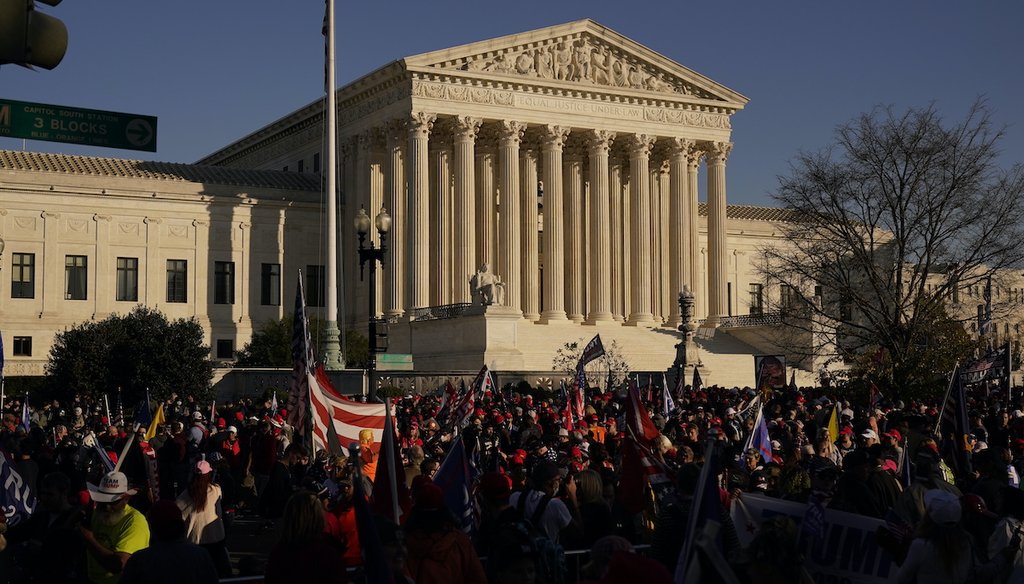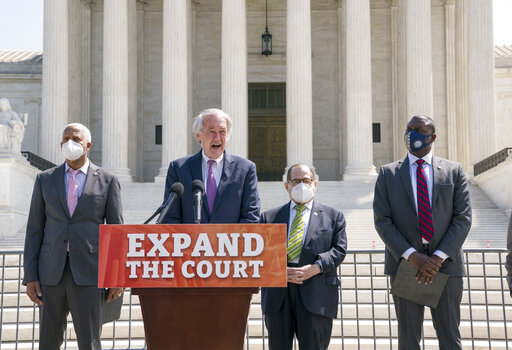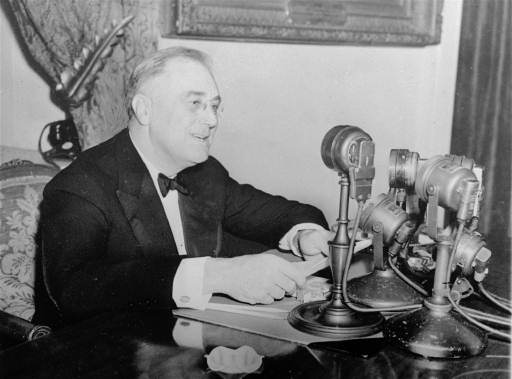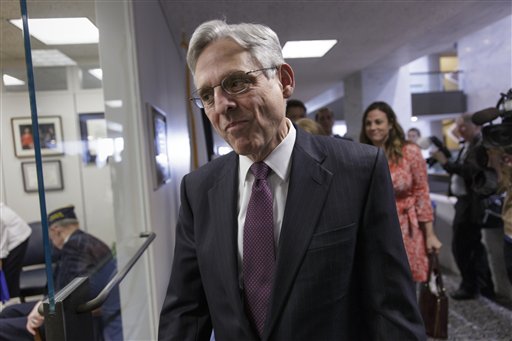Get PolitiFact in your inbox.

Supporters of then-President Donald Trump march outside of the Supreme Court building in Washington on Nov. 14, 2020. (AP)
If Your Time is short
• Democratic lawmakers have introduced a measure to increase the number of Supreme Court justices from nine to 13. They say this is necessary to counter “court packing” by Republicans in the past few years, but Republicans say the Democrats’ bill is itself a clear example of court packing.
• Most experts told PolitiFact that the Democratic bill does qualify as court packing, though some said it was justified given the Republicans’ earlier actions.
• Many experts said they would prefer an overhaul that sets an 18-year term limit on justices, but that would require a constitutional amendment, which would be difficult to enact.
The latest political battle over the Supreme Court is not about filling an open seat, but about how many seats there should be. Several Democratic lawmakers in Congress have introduced legislation to expand the court to 13 justices, up from its current nine.
One of the bill’s sponsors, Rep. Mondaire Jones, D-N.Y., told PolitiFact that Republicans’ recent actions on the Supreme Court amounted to a "subversion of our democracy."
"To unpack the Court, restoring balance and integrity, we can, and must, expand it," Jones said.
Republicans, meanwhile, have counter-attacked using precisely the same language: They say the Democratic bill is itself "court packing."
"They’re introducing a bill to add four new seats to the Supreme Court so that Democrats can pack the Court, destroy its legitimacy, and guarantee the rulings liberals want," said Senate Minority Leader Mitch McConnell.
McConnell pointed to remarks by Justice Stephen Breyer and the late Justice Ruth Bader Ginsburg against expanding the court. Both Breyer and Ginsburg were considered part of the court’s liberal wing.
With both proponents and opponents of the bill accusing the other side of court packing, we thought it would be a good time to dive into the meaning of the term, and the larger debate about reforming the Supreme Court.
Rep. Hank Johnson, D-Ga., Sen. Ed Markey, D-Mass., House Judiciary Committee Chairman Jerrold Nadler, D-N.Y., and Rep. Mondaire Jones, D-N.Y., hold a news conference outside the Supreme Court to announce legislation to expand the number of seats on the high court, on April 15, 2021. (AP)
What is court packing?
The Constitution doesn’t specify the maximum number of Supreme Court seats. It started at six in 1789, briefly fell to five in 1801 before returning to six in 1802. It rose to seven in 1807 and nine in 1837. It rose to 10 in 1863, then shrank to seven in 1866 before stabilizing at nine in 1869.
Initially, the nation was growing geographically, which required more justices, and the increase in 1863 can be explained by the Civil War, which left the court with several justices from states in rebellion.
But experts say "court packing" is different. That involves a party stacking the court with supporters for politically motivated reasons, typically through a departure from ordinary processes. It usually involves adding judicial seats, but has sometimes included strategic shrinkages.
Historians usually point to several specific battles since the nation’s founding that exemplify court packing:
• The "midnight judges." In 1801, following a contentious election, President John Adams sought to stymie the incoming President Thomas Jefferson by adding six new federal circuits with 16 judges, all appointed by Adams. The last-minute appointees came to be known as "midnight judges." Jefferson’s team sought to abolish the new courts, and in 1803, the Supreme Court upheld their right to do so.
• The post-Civil War era. After President Abraham Lincoln’s assassination, Andrew Johnson was elevated to president. When he clashed with Congress, they shrank the Supreme Court from 10 seats to seven, effectively denying Johnson any appointments. After Johnson was succeeded by Ulysses S. Grant, Congress restored the Supreme Court to its current nine.
• President Franklin D. Roosevelt’s 1937 proposal. Frustrated with the justices’ opposition to his New Deal programs, Roosevelt threatened to increase the size of the court by as many as five justices. The scheme was widely seen as a power grab, and it ended up in history’s dustbin.
President Franklin D. Roosevelt talks to the nation in a fireside chat from the White House in November 1937. (AP)
For decades after the failure of Roosevelt’s proposal, the term "court packing" became so toxic that presidents steered clear of such efforts. "It is generally used as a pejorative term, to denounce something that one’s political opponents are engaged in," said Thomas M. Keck, the chair of constitutional law and politics at Syracuse University's Maxwell School of Citizenship & Public Affairs.
Recent battles over the court
As battles over the Supreme Court have intensified in recent years, the term has reemerged as a focus of both sides’ rhetoric.
Merrick Garland, President Barack Obama’s choice to replace the late Justice Antonin Scalia on the Supreme Court, arrives for a meeting with Sen. Elizabeth Warren, D-Mass., on April 14, 2016.
Just weeks before the 2020 election Republicans, led by McConnell, raced to confirm Amy Coney Barrett to the court. That was four years after Republicans blocked President Barack Obama’s pick for the court, Merrick Garland, for more than a year, arguing that the American public had a right to weigh in first. (Garland is now serving as Biden’s attorney general.)
In particular, McConnell’s divergent approaches to the Garland and Barrett nominations led Democrats to charge that his actions were tantamount to court packing.
As the Barrett nomination was under consideration, PolitiFact gave McConnell a Full Flop for changing his position between 2016 and 2020.
"In both cases, McConnell offered a justification that confirmations have proceeded when the presidency and the Senate are in unified control and have stalled when the two are under divided control," we wrote. "However, this isn’t a higher principle that led McConnell to his decision; it’s a cherry-picked, after-the-fact justification for the raw exercise of power he undoubtedly has."
Paul M. Collins Jr., a professor of legal studies and political science at the University of Massachusetts-Amherst, said the actions on Garland and Barrett were "a form of court packing, because it involved an effort to temporarily alter the size of the court to advance the agenda of the Republican Party."
Paul Finkelman, a legal historian who is currently president of Gratz College, agreed. "That is court packing, a political manipulation of the system," he said. "And that is not how it’s supposed to work."
Is the Democratic bill an example of court packing?
As for the Democratic bill, which increases the number of justices from nine to 13, we found widespread agreement among experts that it meets the definition of court packing.
"That’s what ‘court packing’ has long meant — increasing the size of the court to change the likely outcomes of the cases," said Eugene Volokh, a law professor at the University of California-Los Angeles.
"I think it's clear that there's a political motivation for the change," said Sara C. Benesh, a political scientist at University of Wisconsin-Milwaukee. "There's no legal or decision-making reason to want more rather than fewer justices."
The Democratic bill "is raw politics at work," said Stephen B. Presser, an emeritus professor of law at Northwestern University.
We found less consensus among experts about whether the Republicans’ prior treatment of Garland and Barrett justified the Democratic move.
Keck said a court expansion can be justified.
"If it’s the case that Sen. McConnell and other Republican leaders engaged in illegitimate court packing of their own from 2016 to 2020, then from the Democrats’ perspective, an additional round of court reform is necessary to correct for those earlier rounds," he said.
But others said that, even if the Republicans’ actions were questionable or worse, there are practical reasons why a Democratic-backed expansion would be ill-advised.
Volokh expressed concern about a "tit-for-tat pattern — the Republicans did these things to influence the composition of the court, so we the Democrats should do this even bigger thing to compensate. If the Democrats succeed here, then the next time the Republicans take control, it’s a sure bet they’ll likewise play tit-for-tat and expand the Court so that they take it over again. It doesn’t seem like a good long-term solution."
And Ilya Shapiro, vice president of the libertarian Cato Institute, said that "court packing always detracts from the court’s legitimacy by taking away the idea it’s a court of law rather than just another politicized legislative body."
What other reform alternatives are there?
In response to widespread Democratic outrage, President Joe BIden has appointed a commission to study, among other things, "the length of service and turnover of justices on the Court; the membership and size of the Court; and the Court's case selection, rules, and practices." The panel’s members include academics, former federal judges, lawyers and experts on constitutional law, history and political science. The membership leans liberal but includes a number of conservatives as well. (House Speaker Nancy Pelosi, D-Calif., has said she has no intention of giving the court expansion bill a vote, focusing instead on hearing what Biden’s panel concludes.)
Scholars across the ideological spectrum agree that the Supreme Court confirmation process is worthy of an overhaul that doesn’t amount to court packing.
One possibility is to have justices serve 18-year terms, with those terms staggered and timed for non-election years so that each president gets two appointments over a four-year term.
This system would mean that nominations would no longer turn on the timing of the deaths of justices, or retirements timed to whichever party occupies the White House. While individual nominations would still be subject to ideological combat, the regularity of new vacancies could lower the stakes of any individual vacancy.
This system could also diminish the incentive for the president to appoint younger justices, which rules out many older, more experienced nominees, Volokh said.
"I like the idea of 18-year terms, which would work better than a retirement age," said Burt Solomon, author of "FDR v. The Constitution: The Court-Packing Fight and the Triumph of Democracy." "Some justices have been brilliant into their 80s and 90s. I see no reason to jettison them, and I wouldn't consider that ‘packing.’"
This option has the benefit of being popular: An April Ipsos-Reuters poll found that 63% of adults backed the idea of term limits or age limits for Supreme Court justices.
But there’s a practical problem, said Lawrence Baum, an emeritus professor of political science at Ohio State University: "It seems to me quite unlikely that the necessary constitutional amendment could be proposed and ratified." Other experts agreed.
Ultimately, there’s little optimism that the nomination and confirmation process can be improved in the current political climate.
"I don’t think ‘packing the court’ is either advisable or realistic, however much the GOP deserves payback for the Garland-Barrett fiasco," said Peter H. Irons, an emeritus professor of political science at the University of California-San Diego. "There’s nothing sacrosanct about the number nine, but everything about the court is political. Bottom line, to paraphrase Winston Churchill, the status quo is bad, but the alternatives are all worse."
Our Sources
Supreme Court, "The Court as an Institution," accessed April 22, 2021
PolitiFact, "Is Barack Obama trying to 'pack' the D.C. Circuit Court of Appeals?" June 5, 2013
PolitiFact, "Mitch McConnell flip-flops on considering Supreme Court justices in a presidential election year," Sept. 22, 2020
PolitiFact, "Biden forms commission to study changing Supreme Court," April 15, 2021
White House, "President Biden to Sign Executive Order Creating the Presidential Commission on the Supreme Court of the United States," April 9, 2021
NBC News, "Democrats to introduce bill to expand Supreme Court from 9 to 13 justices," April 14, 2021
Fox News, "20 Republican AGs oppose 'alarming' court-packing efforts in letter to Biden, congressional leaders," April 22, 2021
SCOTUSBlog, "In Harvard speech, Breyer speaks out against 'court packing,'" April 7, 2021
NPR, "Justice Ginsburg: 'I Am Very Much Alive,'" July 24, 2019
Mitch McConnell, "McConnell on Court-Packing: 'Responsible People Across the Political Spectrum Have a Duty to Denounce This,'" April 15, 2021
The Hill, "Pelosi says she won't bring bill to expand Supreme Court to the floor," April 15, 2021
Reuters, "Most Americans want to end lifetime Supreme Court appointments," April 18, 2021
Mondaire Jones, statement to PolitiFact, April 19, 2021
Interview with Paul Finkelman, legal historian and president of Gratz College, April 19, 2021
Email interview with Thomas M. Keck, chair of constitutional law and politics at Syracuse University's Maxwell School of Citizenship & Public Affairs, April 19, 2021
Email interview with Paul M. Collins Jr., a professor of legal studies and political science at the University of Massachusetts-Amherst, April 19, 2021
Email interview with Eugene Volokh, law professor at the University of California-Los Angeles, April 19, 2021
Email interview with Ilya Shapiro, vice president of the libertarian Cato Institute, April 19, 2021
Email interview with Sara C. Benesh, political scientist at University of Wisconsin-Milwaukee, April 19, 2021
Email interview with Stephen B. Presser, emeritus professor of law at Northwestern University, April 19, 2021
Email interview with Burt Solomon, author of FDR v. The Constitution: The Court-Packing Fight and the Triumph of Democracy, April 19, 2021
Email interview with Lawrence Baum, emeritus professor of political science at Ohio State University, April 19, 2021
Email interview with Peter H. Irons, emeritus professor of political science at the University of California-San Diego, April 19, 2021







































